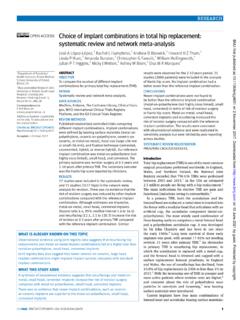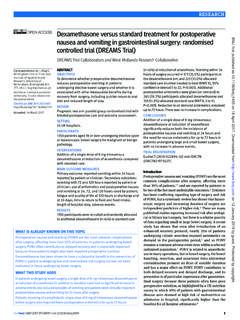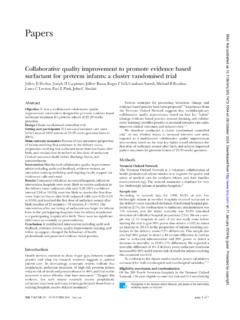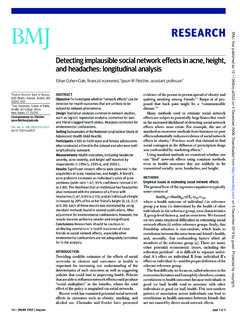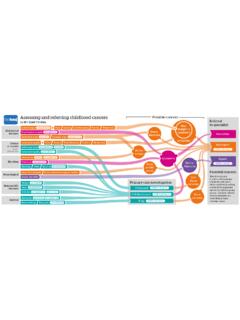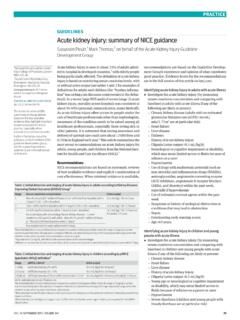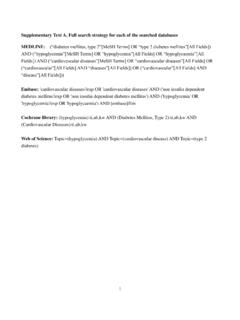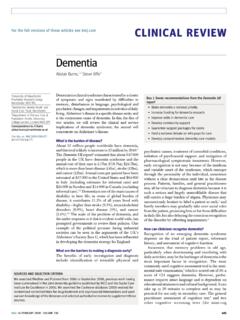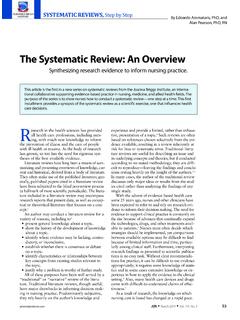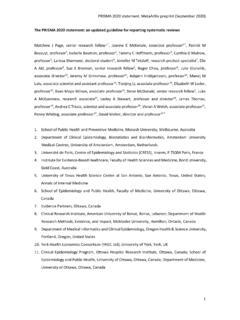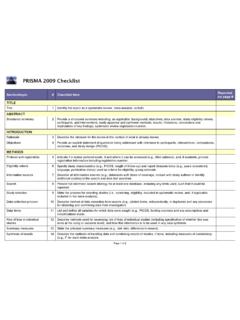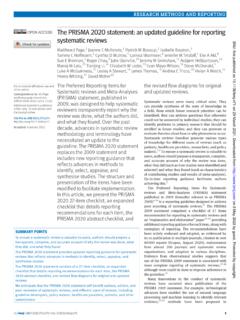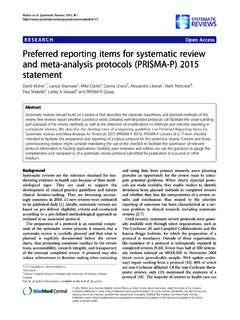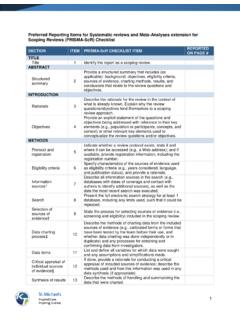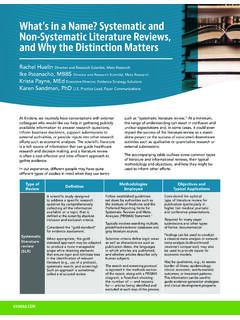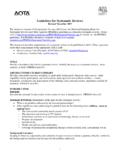Transcription of AMSTAR 2: a critical appraisal tool for systematic reviews ...
1 The bmj | BMJ 2017;358:j4008 | doi: 1 RESEARCH MEtHodS And REpoRtingAMSTAR 2: a critical appraisal tool for systematic reviews that include randomised or non-randomised studies of healthcare interventions, or bothBeverley J Shea,1,2,3 Barnaby C Reeves,4 George Wells,3,5 Micere Thuku1,2 Candyce Hamel,1 Julian Moran,6 David Moher,1,3 Peter Tugwell1,2,3,7 Vivian Welch,2,3 Elizabeth Kristjansson,8 David A Henry9,10,11 The number of published systematic reviews of studies of healthcare interventions has increased rapidly and these are used extensively for clinical and policy decisions. systematic reviews are subject to a range of biases and increasingly include non-randomised studies of interventions. It is important that users can distinguish high quality reviews . Many instruments have been designed to evaluate different aspects of reviews , but there are few comprehensive critical appraisal instruments. AMSTAR was developed to evaluate systematic reviews of randomised trials.
2 In this paper, we report on the updating of AMSTAR and its adaptation to enable more detailed assessment of systematic reviews that include randomised or non-randomised studies of healthcare interventions, or both. With moves to base more decisions on real world observational evidence we believe that AMSTAR 2 will assist decision makers in the identification of high quality systematic reviews , including those based on non-randomised studies of healthcare the rapid increase in biomedical publishing, keeping up with primary research has become almost impossible for healthcare practitioners and policy Consequently, healthcare decision makers rely on systematic reviews as one of the key tools for achieving evidence based systematic reviews provide an opportunity to base decisions on accurate, succinct, credible, and comprehensive summaries of the best available evidence on a accepting the results of a single systematic review has risks.
3 One of us (DM) led efforts to improve standards for reporting of systematic reviews , which led to the PRISMA ( preferred reporting Items for systematic reviews and Meta-Analyses) The reporting guide for systematic reviews of observational (non-randomised) studies is MOOSE (Meta-analysis of Observational Studies in Epidemiology).4 The quality of reporting of a systematic review may, however, more accurately reflect authors ability to write in a comprehensible manner rather than the way they conducted their review . This underscores the need for guidelines that evaluate the way in which reviews are planned and 6 The Cochrane Collaboration Handbook provides a comprehensive guide for review authors, but it does not provide a concise critical appraisal instrument for completed Several instruments have been designed to evaluate individual studies that are being included in systematic reviews or how certain steps (eg, meta-analysis, testing for publication bias) should be But relatively few instruments assess all important steps in the conduct of a (A MeaSurement Tool to Assess systematic reviews )
4 , published in 2007, is one of the most widely used AMSTAR was designed by us and our colleagues as a practical critical appraisal tool for use by health professionals and policy makers who do not necessarily have advanced training in epidemiology, to enable them to carry out rapid and reproducible assessments of the quality of conduct of systematic reviews of randomised controlled trials of interventions. Since publication, several critiques 1 Ottawa Hospital Research Institute, Clinical Epidemiology Program, Ottawa, Canada2 Bruy re Research Institute, Ottawa, Canada3 School of Epidemiology and Public Health, Faculty of Medicine, University of Ottawa, Ottawa, Canada4 School of Clinical Sciences, University of Bristol, Bristol, UK5 University of Ottawa Heart Institute, Ottawa, Canada6 The Hospital for Sick Children, the Genetics and Genome Biology Program, Toronto, Canada7 Department of Medicine, The Ottawa Hospital, Ottawa, Canada8 Centre for Research in Educational and Community Services, School of Psychology, Faculty of Social Sciences, University of Ottawa, Canada9 Centre for Research in Evidence-Based Practice, Bond University, Gold Coast, Australia.
5 10 Dalla Lana School of Public Health, University of Toronto, Toronto, Canada11 Institute for Clinical Evaluative Sciences, Toronto, CanadaCorrespondence to: B J Shea material is published online only. To view please visit the journal this as: BMJ 2017;358:j4008 : 4 August 2017 Summary pointS S ystematic reviews of studies of healthcare interventions effects often include non-randomised studies AMSTAR is a popular instrument for critically appraising systematic reviews of randomised controlled clinical trials AMSTAR underwent further development to enable appraisal of systematic reviews of randomised and non-randomised studies of healthcare interventions The revised instrument ( AMSTAR 2) retains 10 of the original domains, has 16 items in total (compared with 11 in the original), has simpler response categories than the original AMSTAR , includes a more comprehensive user guide, and has an overall rating based on weaknesses in critical domains AMSTAR 2 is not intended to generate an overall score With moves to base more decisions on real world observational evidence, AMSTAR 2 should assist in the identification of high quality systematic reviews on 2 January 2023 by guest.
6 Protected by : first published as on 21 September 2017. Downloaded from RESEARCH MEtHodS And REpoRting2 doi: | BMJ 2017;358:j4008 | the bmjof the instrument have been These critiques plus feedback received at workshops and developments in the science of systematic reviews pointed to a need to revise and update the original AMSTAR of non-randomised studies in systematic reviewsAlmost half of published systematic reviews now include non-randomised studies of intervention 32-34 There are many concerns about the conduct and reporting of systematic reviews of non-randomised 35 36 To summarise, non-randomised studies of healthcare interventions (an important focus of this revision of AMSTAR ) are subject to a range of biases that are either not present or are less noticeable in randomised controlled trials, thus requiring different risk of bias assessments.
7 Observational studies are increasingly conducted within large population databases, sometimes with hundreds of thousands or even millions of recipients of healthcare interventions. These generate precise estimates of intervention effects, which may be inaccurate because of residual biases. If these estimates are combined with those from the (generally smaller) randomised controlled trials, the meta-estimates will be weighted towards the observational study estimates. The original AMSTAR instrument did not include an assessment of the risk of bias in non-randomised studies included in a review , which is a key issue given the diversity of designs that such studies may use and the biases that may affect of AMSTAR 2 The development and validation of the original AMSTAR instrument (published in 2007) has been described in detail Briefly, the original list of items was created from the results of a scoping review of the then available rating instruments.
8 This review identified many over-lapping appraisal items, mainly from two extensively cited 17 The lists of items from these reports were combined and reduced by factor analysis. After pilot testing, items were reworded as needed and the reliability and usability of the tool was assessed. A modified version was validated externally and performed well against the global judgments of a panel of content The publications describing the original AMSTAR instrument were widely cited and the instrument has been used and critiqued convened an expert group, comprising authors of the original instrument, members with expertise in the conduct of non-randomised studies, development of appraisal instruments, biostatistics, and study designs. The expert group met for a day in Ottawa, Canada and members were presented with the results of updated literature reviews on relevant critical appraisal instruments, the results of surveys of AMSTAR users, recorded experience of participants in AMSTAR workshops at Cochrane Colloquiums in 2015 and 2016, feedback from the AMSTAR website ( ), and published critiques of the original The perspective adopted by the expert group was to increase the value of AMSTAR as a broad critical appraisal instrument designed primarily for systematic reviews of studies of healthcare interventions.
9 The expert group considered that revisions should address all aspects of the conduct of a systematic review , and the challenges of including non-randomised studies. They also thought the revised instrument should function as a teaching aid and as a concise checklist for those conducting reviews . The revisions were not intended to deal with the special requirements of diagnostic test reviews , individual patient data meta-analyses or network meta-analyses, scoping reviews , or realist used a nominal group technique to propose and then prioritise specific changes to the instrument and to agree on the draft wording of items. Based on their experience of the instrument and the presentations made at the meeting, participants were asked to record their ideas independently and privately. The ideas were then enunciated in a round-robin format.
10 One idea was collected from everyone, in turn, and presented to the group by the facilitator. This process was continued until all ideas had been listed. Individuals then privately recorded their judgments and rankings. These were aggregated statistically to derive the group judgments. The following changes were agreed on (these are not listed in order of priority as all were considered important enough to mandate modifications to the instrument): Simplify the response categories Align the definition of research questions with the PICO (population, intervention, control group, outcome) framework Seek justification for the review authors selection of different study designs (randomised and non-randomised) for inclusion in systematic reviews Seek more details on reasons for exclusion of studies from the review Determine whether the review authors had made a sufficiently detailed assessment of risk of bias for the included studies (whether randomised or non-randomised) Determine whether risk of bias with included studies was considered adequately during statistical pooling of results (if this was performed) Determine whether risk of bias with included studies was considered adequately when interpreting and discussing the review description was formulated for each of the draft items.


